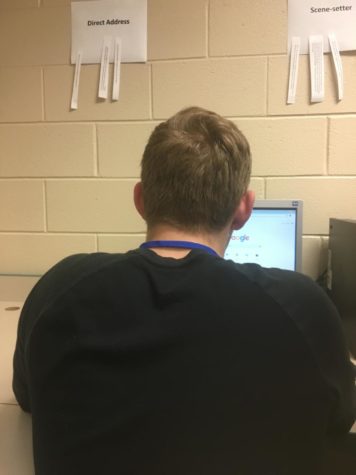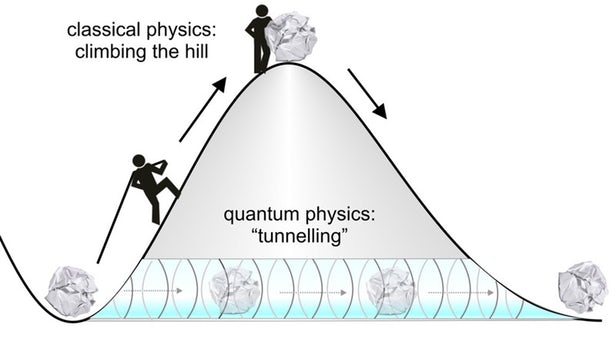Spaghetti and Meatballs
Recent Scientific Developments Challenge People’s Perception of Physics’ Boundaries
Shown here is an example of an object passing through a solid hill, occupying the same space as it, and being on the other side all at once without any known explanation credit: New Atlas
This past week has been a rush for the scientific community. From groundbreaking discoveries in time travel, to elapsed time of quantum tunneling, new doors are opening in the wild world of theoretical physics.

When asked of his thoughts on recent developments in time travel, student David Berry first said, “WhO?’ and then, “oH me gUsta”.
Things begin with a now broken fact, “An isolated system either remains static or evolves toward a state of chaos rather than order,” the second law of thermodynamics. It is the reason people perceive a reversed video of billiard balls breaking from their triangle. Such film would obviously be doctored to anyone with the most basic understanding of the game. But on a smaller scale, one not even fully understood by modern science, these all encompassing, disgustingly limited human rules fall apart.
For we have no explanation of why, when testing a single electron in a program performed on a quantum computer, the electron somehow goes back in time. This is not to say it had any risky encounters with dinosaurs or the Axis powers of WWII, the particle only pushed itself back into its previous state of a few minutes ago. It’s incredible to imagine that suddenly, so much of science fiction can be introduced into reality without a moment’s notice and rejuvenate our human preparedness for wonder. The experiment didn’t stop here either. Further tests are being prepared to measure probabilities of similar particles to transport themselves through time but under varying conditions. Even beyond this, two other, eyebrow-raisingly similar experiments proved successful in showing how little we know. Two scientists were able to prove, with as much conviction as one can, the very true presence of another plane. They made another reality visible.

Another student, Jacob Barton, declined showing his face to our cameras but did point out that the idea of time travel was, “Trippy bro”
This was on a tiny scale of course, as opposed to lab created wormholes, but incredible nonetheless. The state of a quantum particle was recorded by one scientist, but not observed. Another scientist observed the particle and assessed its state based on observation. After both reviewed and compared their assessments of the particle’s position and state, the scientists found the particle had been in two states at once. This is similar to Schrödinger questions which states that something is both present and not present until it is measured or recorded. The simple fact that scientists were able to effectively measure both of these contradictory states makes insinuations of alternate realities plausible, as both states of an object can’t exist at the same time and therefore there is another indistinguishable plane on which they are existing.

Jarel White, another pupil of Lafayette high school was visibly excited about Moscow’s quantum computer and told us, “They’re really clappin the game and spittin the cheeks.”
The final experiment took place only a few days ago, testing a previously unexplored aspect of quantum tunneling: how long it takes. Quantum tunneling is the process certain subatomic particles go through when moving from place to place, owing its inception to the current “electron cloud model.” Objects like electrons do not transport themselves across terrain by any conventional means. Instead they are in one place and then suddenly appear in the next. Most interesting about this phenomenon is the limited understanding people have of linear time.

How can a particle be somewhere and also somewhere else in the same instant while still not being in two places at once? While the answer to this intriguing question hasn’t been found yet, scientists have been able to discover that these subatomic particles can just instantly exist on the other side of barriers indicating that at least on such a small scale, quantum tunneling is something effectively instantaneous and totally ignorant of physical boundaries.




